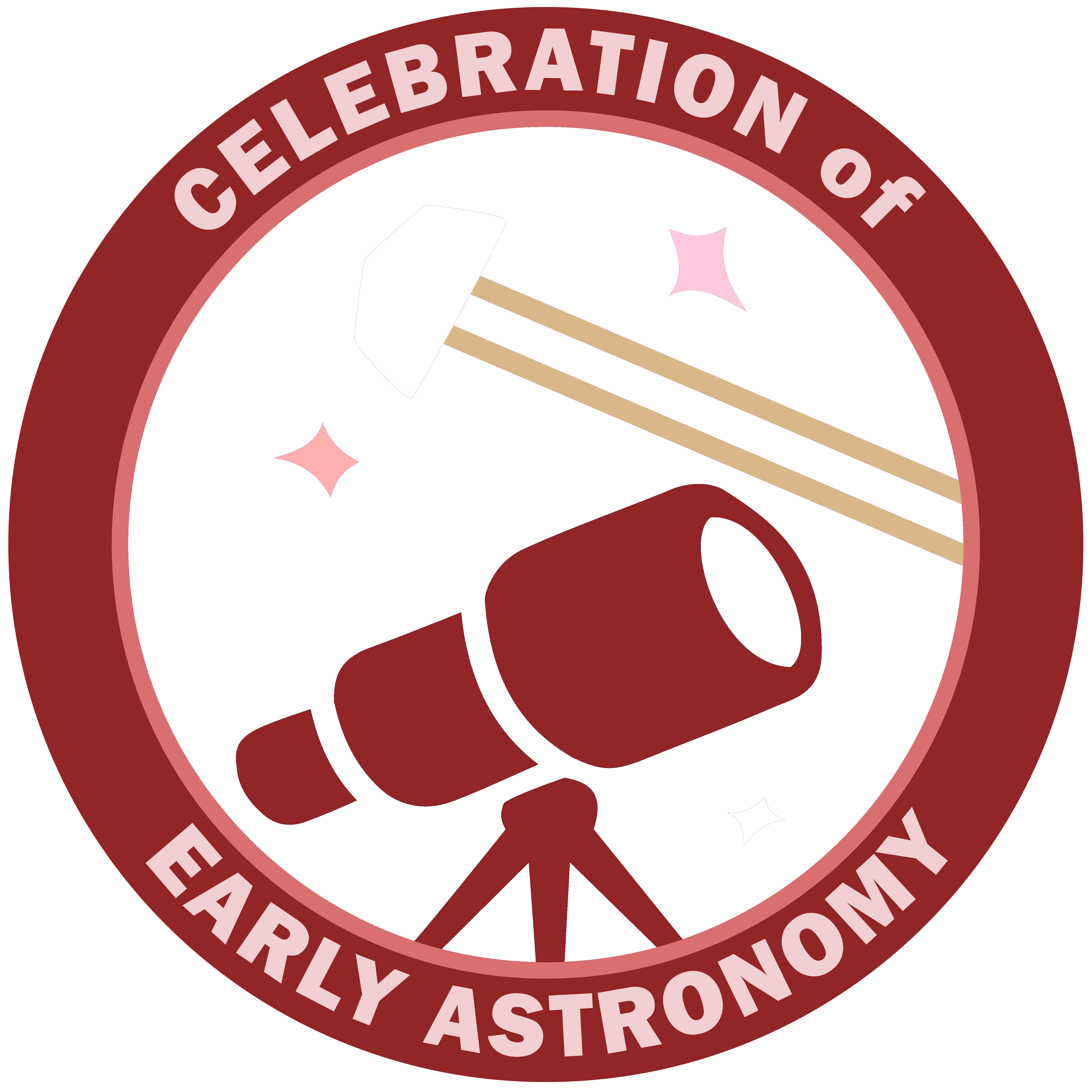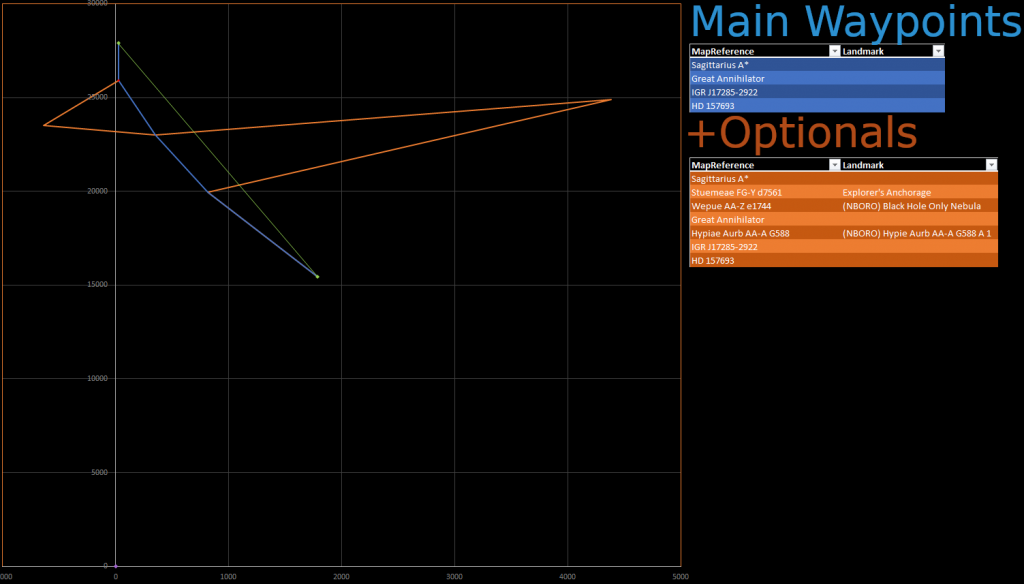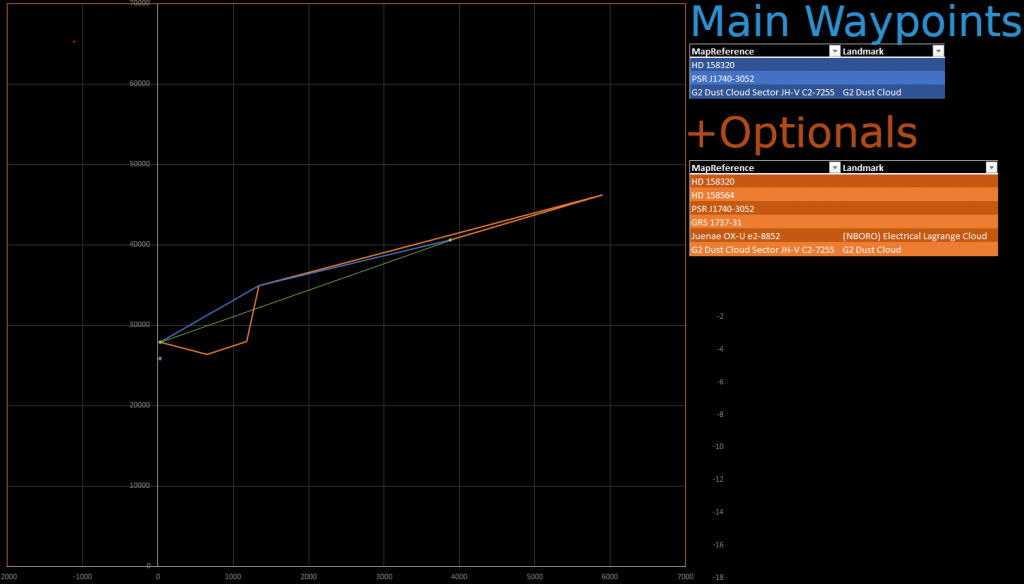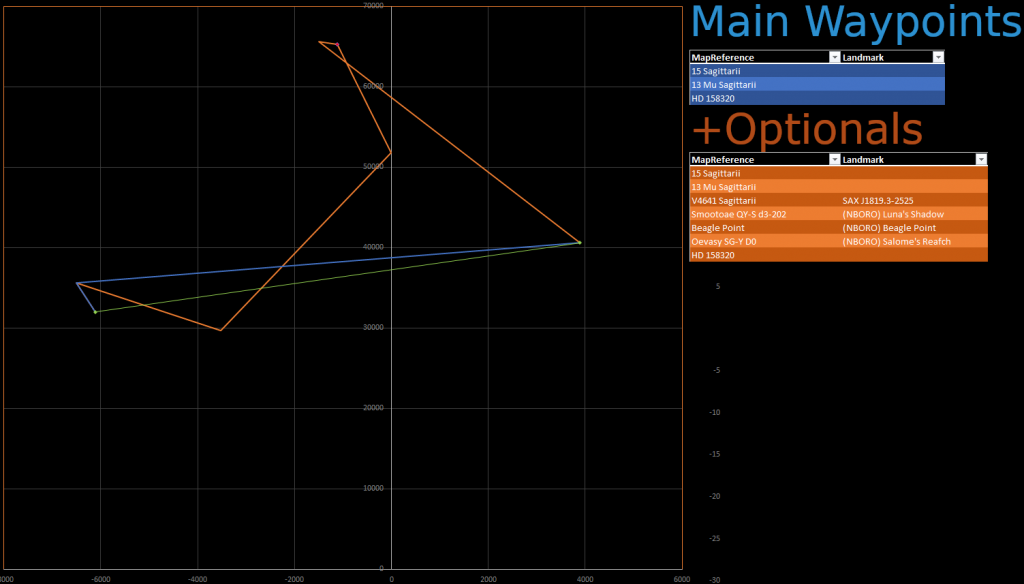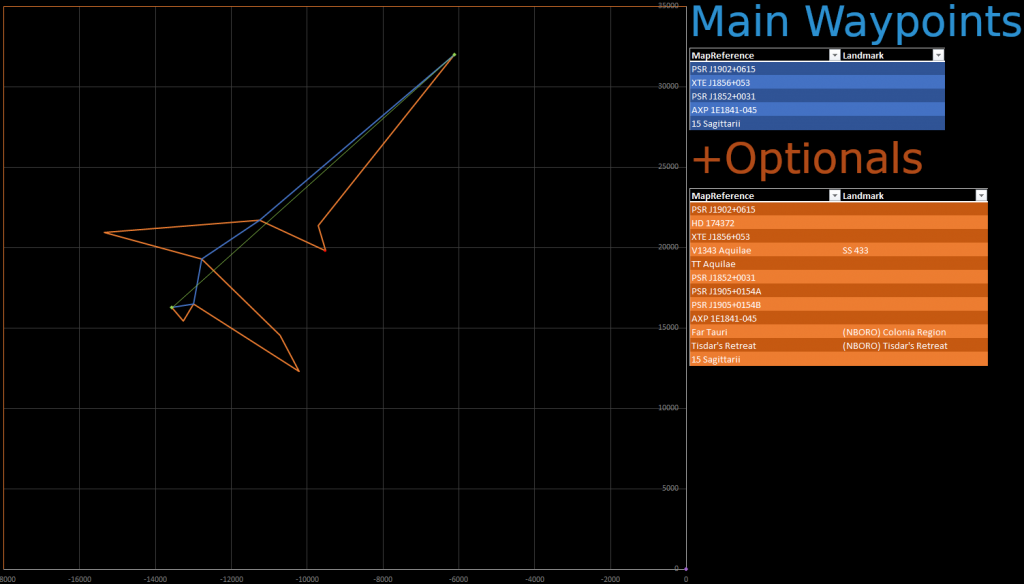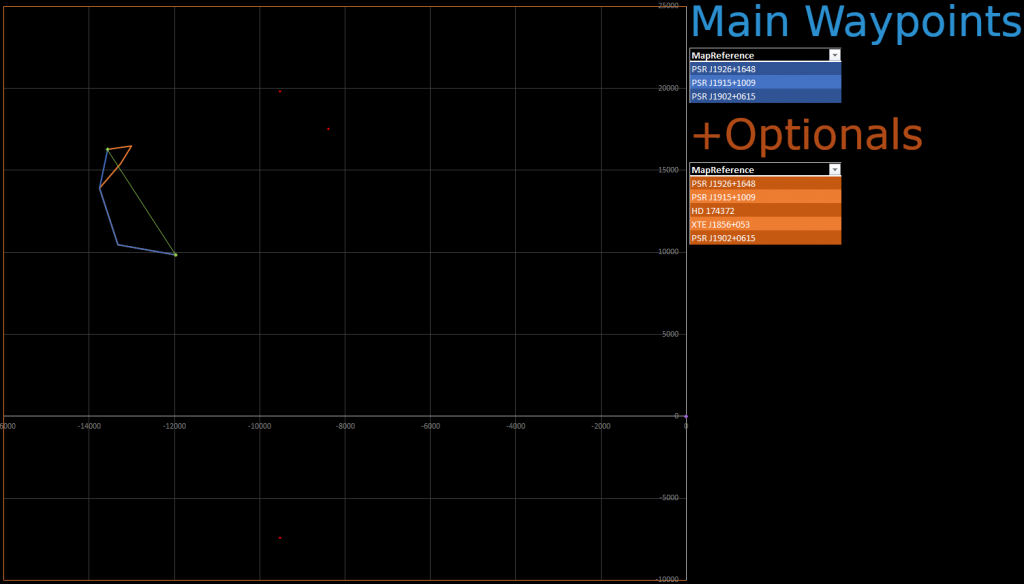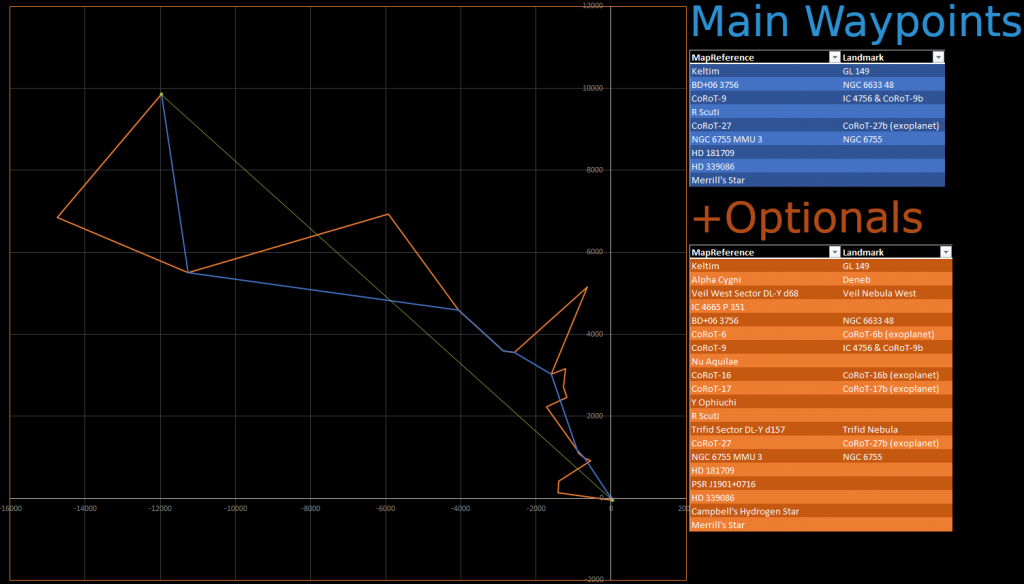This is the final leg of the Celebration of Early Astronomy 3 expedition. At the end we shall have an extended basecamp end party in T Tauri inside the beautiful Hind Planetary Nebula.
Dates
Start Date: September 18, 2021
End Date: October 2, 2021
Note: EDSM Tracking will be active for stragglers until November 3, 2021
Distances
Basecamp Line: 16,089.86 Ly
Main Waypoints: 16,122.92 Ly
Optional Waypoints: 16,760.77 Ly
Map, (click for full size):
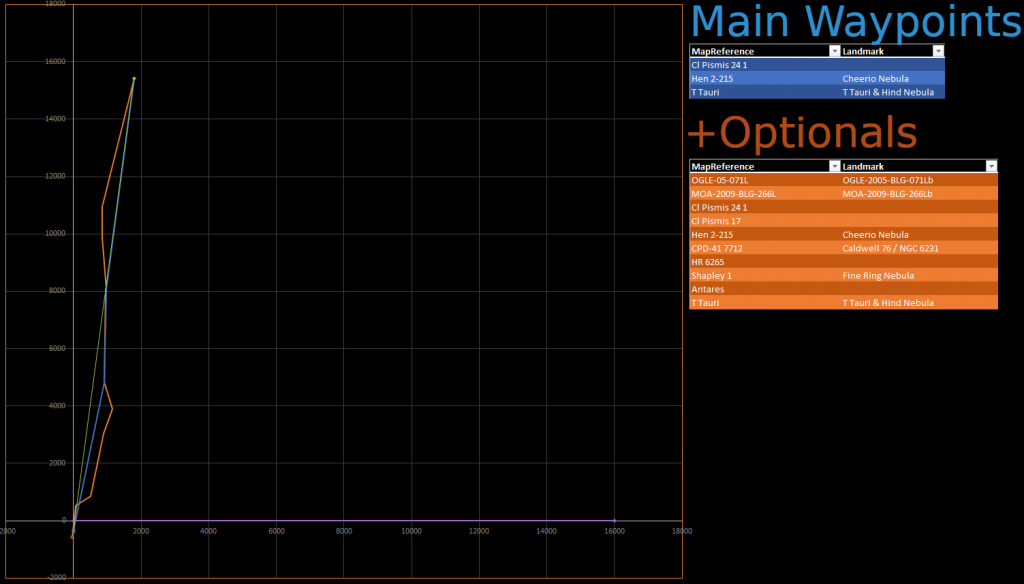
Basecamp: T Tauri
Main Waypoints
- Map References quick reference list, more details below
- Cl Pismis 24 1
- Hen 2-215
- T Tauri
Main Waypoints Details
- Map Reference: Cl Pismis 24 1
- Cl Pismis 24 1, is a binary system in the Pismis cluster within the NGC 6357 nebula. It was originally thought to be the most massive and luminous known star at an estimated 200 to 300 solar masses. However, later observations and scientific advancements allowed for it to be resolved that it was two stars orbiting each other, each still among the most massive and luminous known stars in existence respectively.
Further observations since the in-game galaxy was made in 2013 also suggest that one of the stars may be a very compact binary of it’s own, but we have so far been unable to conclusively determine that. - SIMBAD Link
- Cl Pismis 24 1, is a binary system in the Pismis cluster within the NGC 6357 nebula. It was originally thought to be the most massive and luminous known star at an estimated 200 to 300 solar masses. However, later observations and scientific advancements allowed for it to be resolved that it was two stars orbiting each other, each still among the most massive and luminous known stars in existence respectively.
- Map Reference: Hen 2-215
- POI: Cheerio Nebula
- NGC 6337, also known as the Cheerio Nebula is a toroidal planetary nebula in the Scorpius constellation. It appears as a ring shaped transparent nebula. There is convincing evidence that a binary nucleus exists at the center of the planetary nebula.
- Map Reference: T Tauri
- POI 1: T Tauri
- POI 2: Hind Variable Nebula
- T Tauri is a variable star in the Taurus constellation, and the prototypical star of the T Tauri class of variable stars. It was discovered in October 1852 by John Russel Hind, after which it’s planetary nebula, the Hind Variable Nebula was also named. — Strangely enough despite being the prototype star of the T Tauri classe of stars, the in-game representation does not have them as T Tauri stars.
Optional Waypoints
- Map References quick reference list, more details below
- OGLE-05-071L
- MOA-2009-BLG-266L
- Cl Pismis 24 1
- Cl Pismis 17
- Hen 2-215
- CDP-41 7712
- HR 6265
- Shapley 1
- Antares
- T Tauri
Optional Waypoints Details
- Map Reference: OGLE-05-071L
- AKA: OGLE-2005-BLG-071Lb
- OGLE-2005-BLG-071Lb is an exoplanet discovered by the Optical Gravitational Lensing Experiment in 2005 using gravitational microlensing. It is believed to have about 3.5 times the mass of Jupiter and orbit roughly 3.6 AU from the star. However another model predicts a slightly lower mass of 3.3 times Jupiter mass and an orbit of 2.1 AU and is considered only slightly less likely of a match.
- SIMBAD Link
- EDSM Link
- Map Reference: MOA-2009-BLG-266L
- POI: MOA-2009-BLG-266Lb
- MOA-2009-BLG-266Lb is an exoplanet discovered in 2010 using gravitational microlensing. It is believed to have a mass of roughly a quarter of Jupiter’s mass, and orbits at a range of about 3.2 AU from its parent star.
- SIMBAD Link
- EDSM Link
- Map Reference: Cl Pismis 17
- This system is also part of the Pismis cluster, it is the one we used for our basecamp on CEA 1 on planet “7 B A” at Bio Site 1. There are biologicals here to possibly check out as well for those interested.
- SIMBAD Link
- EDSM Link
- Map Reference: CDP-41 7712
- AKA: Caldwell 76, NGC 6231
- Caldwell 76, also known as NGC 6231 is an open cluster in the southern sky. It is a swath of young bluish stars in the constellation Scorpius
- SIMBAD Link
- EDSM Link
- Map Reference: HR 6265
- HR 6265, commonly known as HD 152270 is a Wolf-Rayet star with a white dwarf companion in the NGC 6231 open cluster.
- Map Reference: Shapley 1
- POI: Fine Ring Nebula
- Shapley 1 was discovered in 1936 by Harlow Shapley, it is an annular planetary nebula viewed from Earth almost perfectly perpindicular. In reality it is determined that the central star is a white dwarf, however in-game it is represented by a Wolf-Rayet. This may be due to new data since the in-game galaxy was created.
- Map Reference: Antares
- The 15th brightest star in the night sky and the brightest star in the Scorpius constellation. It is often referred to as The Heart of the Scorpion because of its distinct red hue when viewed with the naked eye.
It is a red supergiant and among the largest known stars. It also has a companion star Antares B which is a typical B-class star - Note: Previously this system would jump you into the “B” star for whatever reason. Not sure if this is still the case in Odyssey.
- The 15th brightest star in the night sky and the brightest star in the Scorpius constellation. It is often referred to as The Heart of the Scorpion because of its distinct red hue when viewed with the naked eye.
